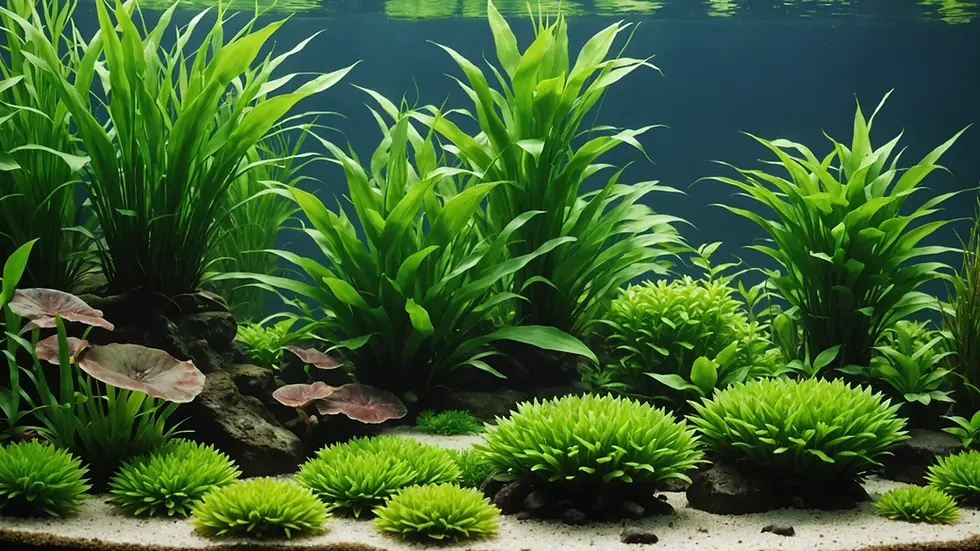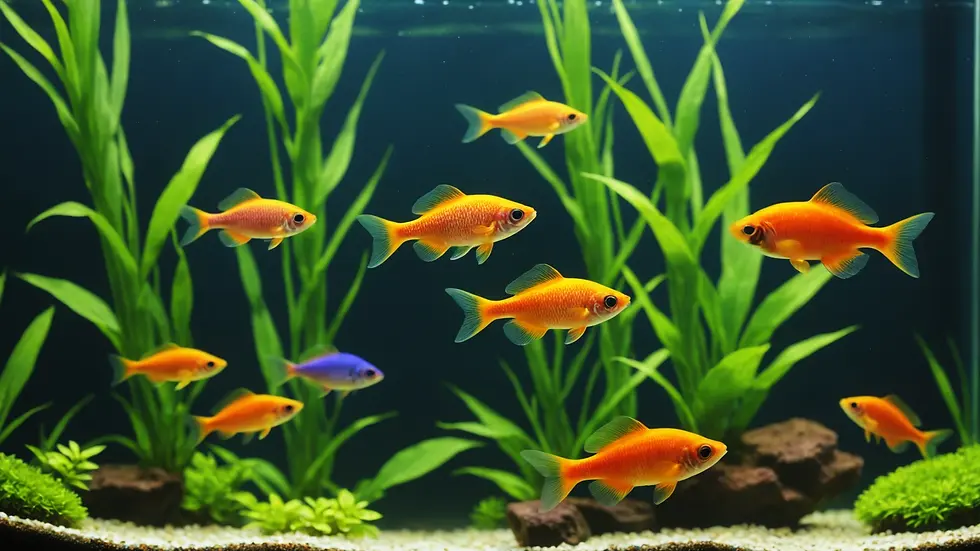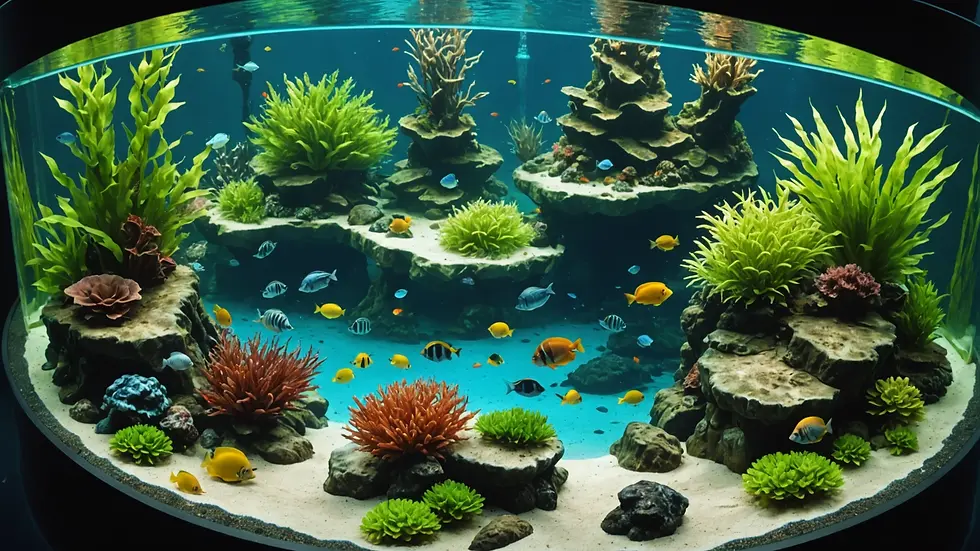What Are the Ideal Conditions for Creating a Healthy Environment for Rasbora Schooling?
- Jyotiraj Borah
- Feb 10
- 4 min read
Creating a vibrant environment for Rasbora schooling is key to the health of these beautiful fish and the attractiveness of your aquarium. Known for their lively behavior and stunning colors, Rasboras thrive in schools, making them a highlight in any aquatic setup. This post will explore the specific requirements that ensure a thriving community of Rasboras, bringing life and color to your home.
Understanding Rasbora Fish
Rasboras are small freshwater fish from the Cyprinidae family. Hailing from Southeast Asia, they are cherished by aquarium lovers for their calm demeanor and vivid hues. To maintain their natural behavior, keep at least six Rasboras together, as they are social fish that need companionship to flourish.
Tank Size and Shape
Choosing the right tank is the first step to a healthy Rasbora environment. A minimum of 20 gallons is recommended for a school of Rasboras. While they can survive in smaller spaces, a larger tank enhances their schooling behavior and maintains overall water quality.
Opt for a longer tank rather than a tall one. Longer tanks provide more swimming space, crucial for active schooling fish, allowing them to exhibit their natural behaviors more freely.
Water Parameters: Temperature, pH, and Hardness
Water quality is vital in maintaining a healthy environment for Rasboras. Here are some key parameters to focus on:
Temperature
Rasboras enjoy warmer waters, ideally between 75°F to 82°F (24°C to 28°C). It is critical to use a reliable heater to keep the tank temperature consistent, as fluctuations can stress these sensitive fish.
pH Level
Maintain pH levels slightly acidic to neutral, ideally between 6.0 to 7.5. Regular testing helps you keep the environment stable, which is crucial for the health of your Rasboras.
Water Hardness
Rasboras do best in soft to moderately hard water, with a hardness between 2 to 12 dGH. If your water hardness is outside this range, using a suitable water conditioner can help adjust the levels.
Filtration and Aeration
Effective filtration is essential for keeping your aquarium's water clean and oxygen-rich. Rasboras are particularly sensitive to poor water quality, so investing in a quality filtration system that includes mechanical, biological, and chemical filtration is a wise choice.
Aeration is another factor to enhance water quality. While Rasboras can adapt to lower oxygen levels, they thrive in well-aerated tanks. An air pump with an air stone can increase oxygen levels, leading to healthier fish.
Substrate and Decorations
To recreate a natural habitat, carefully select your substrate and decorations. Use sand or fine gravel as a substrate, mimicking their wild environment.
Plant Life
Incorporating live plants adds beauty to your aquarium and offers hiding spots for Rasboras. Plants create shaded areas and resting spots, promoting a sense of security for the fish.

Hiding Places
Add decorations like driftwood or rocks to create caves and shaded spots. These features give Rasboras a safe retreat when they feel threatened, encouraging natural schooling behaviors.
Feeding Rasboras
A balanced diet is crucial for Rasbora health. Being omnivorous, they thrive on a mixture of high-quality flakes, pellets, and live or frozen foods like brine shrimp and daphnia.
Feed them small quantities two to three times a day, ensuring the food is consumed within a few minutes to maintain water quality and reduce waste.
Keeping Compatible Tank Mates
Rasboras are peaceful fish that can live with many species, but it is essential to choose non-aggressive companions. Good tank mates include:
Tetras
Gouramis
Corydoras Catfish
Other small community fish
Monitor for aggressive behavior when introducing new tank mates and be ready to relocate any that disrupt harmony in the tank.
Lighting Conditions
Proper lighting is essential for both the fish and the overall look of the tank. Rasboras prefer moderate lighting because too much brightness can cause stress. Using an LED lighting system with a timer can simulate day and night cycles, benefiting the fish's natural behavior.
Regular Maintenance and Water Changes
Regular maintenance is critical for the well-being of your Rasbora school. Key tasks include:
Weekly Water Changes: A 25% water change weekly helps remove toxins and replenish essential minerals.
Testing Water Parameters: Regularly check for ammonia, nitrate, and nitrite levels to maintain a stable environment.
Cleaning the Tank: Keep algae and debris at bay to ensure a clean habitat without disturbing the fish's environment.
Understanding Behavior and Health Monitoring
Keeping an eye on your Rasboras' behavior is essential for spotting stress or illness early. Healthy Rasboras swim actively, school closely, and display vibrant colors.
Watch for signs of stress, such as:
Excessive hiding
Gasping at the water's surface
Diminished color vibrancy
If concerning behaviors arise, check your water parameters and consider consulting a veterinarian who specializes in fish care.
Breeding Rasboras
If breeding interests you, set up a separate breeding tank with gentle filtration and ample plant cover. Breeding is straightforward, as these fish readily spawn in schools.
Spawning conditions
To encourage breeding, adjust these conditions:
Maintain slightly acidic water (pH 6.0 - 6.5).
Provide spawning mops or fine-leaved plants for egg laying.
After spawning, it's wise to separate the parents to prevent them from eating the eggs.
Elevating Your Aquarium Experience
Creating a healthy environment for your Rasbora school involves attention to detail and consistent upkeep. By ensuring the right tank conditions, water parameters, diet, and compatible tank mates, you can cultivate a dynamic habitat that fosters their natural behaviors and promotes their health.
Incorporating these elements allows you to enjoy a lively community of Rasboras that adds color and movement to your aquarium. Remember to regularly monitor your fish and stay proactive with maintenance—your Rasbora school will reward you with their captivating presence.

By making these adjustments to your aquarium, you can fully appreciate the stunning beauty that a school of Rasboras brings, along with the satisfaction that comes from providing them with a healthy habitat.





Comments